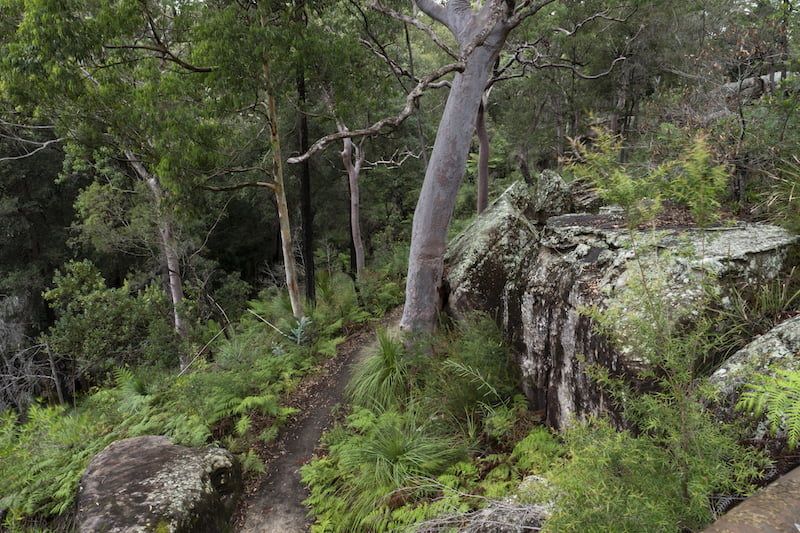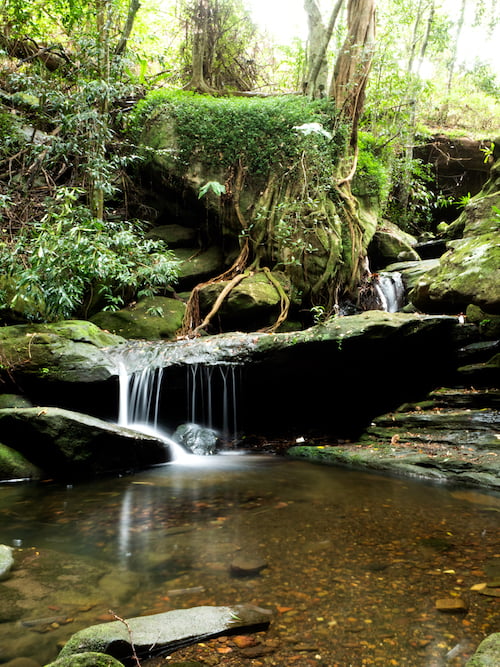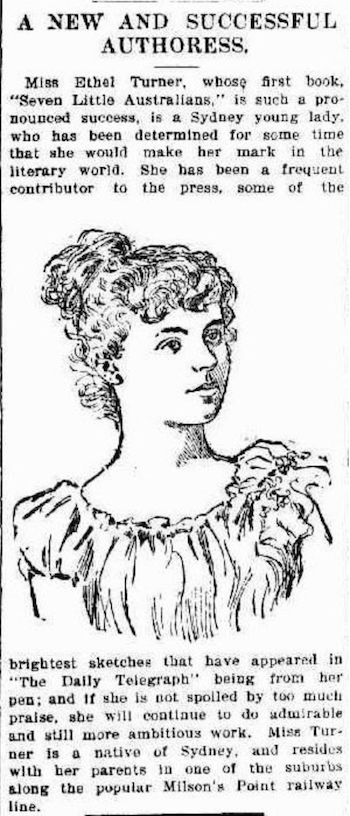“Before you fairly start this story, I should like to give you just a word of warning. If you imagine you are going to read of model children…you had better lay down the book immediately…Not one of the seven is really good, for the excellent reason that Australian children never are…There is a lurking sparkle of joyousness and rebellion and mischief in nature here, and therefore in children”. Ethel Turner, Seven Little Australians
Wandering the paths of Seven Little Australians Park in Sydney’s leafy north shore area of Ku-ring-gai, you can feel that joyousness of nature seeping into your soul.

Top down from Turner Lookout
This delightful little park is nestled in the gullies and along the creeks of the leafy suburb of Killara and Lindfield on Sydney’s north shore.
It’s a park steeped in history with its majestic blue gums and Bunya Bunya Pines, beautiful sandstone ledges and escarpments, elegant sandstone paths and stonework built in the Great Depression years and rippling creeks and waterfalls. Perhaps one can sense the echo of the Guringai people who walked these lands for thousands of years before this story began.

Waterfall in the rain
Ethel Turner comes to Lindfield
In 1891, when Ethel Turner, the 19-year-old budding author, learnt that her family was moving to Lindfield, she was appalled. She thought it’d be ‘like being buried alive to live in a quiet little country place after the bustle and excitement of town life’.
But she soon changed her tune.

Daily Telegraph (Sydney, NSW / 1883 – 1930), Saturday 10 November 1894, page 9, courtesy Trove
The area of Ku-ring-gai began to flourish as a settlement from 1890, with the opening of the first stage of the railway line. Before that, a collection of isolated rural communities earned their living from timber-getting, fruit growing and market gardens.

Lindfield Railway station 1908. Image courtesy Ku-ring-gai Library Collection
Once the railway was built, it was easier to get into and out of town and Ku-ring-gai blossomed. The foresight of the building surveyors and planners of the time meant that the area adopted the principles of a garden city with individual homes, private gardens and vegetable patches.

Ethel Turner, 1927, photo by May Moore (Courtesy State Library of NSW)
For Ethel, the area was clean and beautiful after the grime of Sydney’s CBD. The house in which she lived was spacious and elegant. And just around the corner were acres of natural bushland.

Fern path in Seven Little Australians Park
It was here that she wrote the highly successful children’s book, Seven Little Australians. While not set on the north shore, we hope that the pristine bush setting (albeit with all the big trees removed by timber getters) inspired her writing. It was much later, in 1980, that a portion of the park, then called Lindfield Solders’ Memorial Park, was carved off and renamed Seven Little Australians Park in honour of Ethel.
Published in 1894, Seven Little Australians tells the story of seven children living in 1880’s Sydney with their father, the somewhat distant Captain Woolcot and their 20-year-old step-mother, Esther, neither of whom have much luck in exerting any influence over the wayward children.

Book, Seven Little Australians
The book has been continually in print for over 100 years. Selling more than 2 million copies in English, it has been translated into many languages and adapted as a stage play in 1914, into a film in 1939, a BBC series in 1953, a 10-episode ABC series in 1973 and a musical theatre adaptation in 1988.
Sandstone pillars, paths and steps adorn the park
“A wind from the river swept through the belt of gum trees on the Crown lands, and sent the young red blood leaping through their veins; it played havoc with Judy’s curls, and dyed her brown cheeks a warm red.” Ethel Turner, Seven Little Australians
Fast forward from Ethel’s writing of Seven Little Australians to the Stock Market Crash of 1929.
The Great Depression hit Australia hard. Unemployment soared to 32 per cent by 1932. The Australian Government responded to the suffering by allocating £1,000,000 to the states for unemployment relief. New South Wales received £276,000 of this and with £15,000 of those funds, and another £4,000 from Ku-ring-gai Council, the Eastern Arterial Road was constructed. Reaching from Chatswood to Killara and northwards, the aim was to further open up the north shore and provide an alternate route to the winding Pacific Highway.

Building Eastern Arterial Road Nov 1930, Ku-ring-gai Municipal Council Historic Photo Collection
Over 300 men were employed for 5 months to build the road, providing temporary relief for at least some families.

Entrance to Seven Little Australians Park
As part of that work, the park received a face lift! Overseen by RH (Harry) Patterson, the Building Surveyor and Parks Officer at Ku-ring-gai Council from 1926 to 1938, the men employed through the Unemployment Scheme constructed a series of sandstone paths and stairs through Seven Little Australians Park along with the sandstone pillars which reinforce a massive rock overhang. The paths and stairs would have been hand-hewn and placed. A massive effort and still mostly intact today.

Steps through the park
The sophistication and practicality of the planners of that era is inspiring. The 1932 Annual Report of the Parks and Playgrounds Movement of NSW stated: “Under the artificial conditions of present-day civilised life, especially in the cities, play is not merely an accessory to healthy life, but a definite essential, possibly necessary for the actual survival of the race. Abundant authority could be cited as to the effect of outdoor play and recreation on the bodily and mental growth of nations.”

Sandstone pillars built in the 1930s
The landscape and vegetation
The park itself is situated in a series of gullies, both south facing, where rainforest type species predominate, and north facing, where the slope is more gradual and open sclerophyll forest prevails.
The paths meander along the creek line at the bottom of the gullies, both Gordon Creek and Shot Machine Creek, and small waterfalls cascade nearly all the time.

Little waterfall
In the open forest, Angophora costata (Smooth-barked Apple), Eucalyptus saligna (Sydney Blue Gum), Syncarpia glomulifera (Turpentines), Eucalyptus pilularis (Blackbutt) and Casuarina littoralis (Black She-oak) abound.

Groves of trees along the creek line
Massive Araucaria bidwillii (Bunya Bunya Pine) and Araucaria cunninghamii (Hoop Pine), thrive along the creek bed, alongside groves of Ceratopetalum apetalum (Coachwood),Tristaniopsis laurina (Water Gum) and Lillypilly.

Grass trees and gums
Xanthorrhoea (Grass trees) are prolific in the under storey, as are Banksia spinulosa, Dodonaea, Pomaderris, Melaleuca (Paperbark) and Acacia spp. (Wattle). Gahnia, Asplenium (Bird’s Nest Fern) and tree ferns abound.

Banksia spinulosa

Pomaderris

Gahnia aspera
The Crowea saligna are flowering and the acacias are just starting up.

Crowea saligna
And this little white flowered ground cover, Platysace linearifolia or Carrot Tops, is a delicate delight.

Carrot Tops, Platysace linearifolia
This delightful park is a wonderful and restful place to walk and explore. Perhaps you’ll feel, like I do, the history and landscape seeping into your soul, filling you with wonder for both the present and the past.
Thank you to Ku-ring-gai Library for their generous support in researching this article.
“…the kukuburra slumbered all night in a ti-tree hard by; but when the sun crept up the sky again they woke with a laugh on their lips–beaks, I should say, Miss Judy–remembering the escape of the jeeda from the merciless wipparoo. And ever since then, so strongly did the incident tickle their risible faculties, at sunrise and sunset, and occasionally between whiles, these particular birds burst into the cachinnations of laughter you are all familiar with…”
Bibliography
Buchanan, RA, 1983, Bushland Management Survey, Vol II, Field Report
Curby, P and Macleod, V, 2006, Under the Canopy, Ku-ring-gai Council
Ku-ring-gai Historical Society, 1996, Focus on Ku-ring-gai, Wendy Farley, Kneebone Media
Ku-ring-gai Library, 1979 to 1983, Naming of Seven Little Australians Park & Turner Lookout
Ku-ring-gai Library, 2018, Ethel Turner
State Library, N.d., Ethel Turner, 1927/photographic portrait by May Moore, Sydney, accessed 5 June 2018, http://archival.sl.nsw.gov.au/Details/archive/110335619,
Trove, 1894, ‘A New and Successful Authoress’, The Daily Telegraph (Sydney, NSW: 1883 – 1930), 10 November, p. 9, accessed 05 Jun 2018, http://nla.gov.au/nla.news-article236109006
Turner, Ethel, 1896, Seven Little Australians, Ward, Lock & Bowden, Limited, London
Wikipedia, N.d., Seven Little Australians, accessed 3 June 2018, https://en.wikipedia.org/wiki/Seven_Little_Australians
